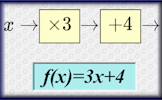Here are some specific activities, investigations or visual aids we have picked out. Click anywhere in the grey area to access the resource.
Here are some exam-style questions on this statement:
- "\(f(x) = \frac{2x}{5} + 7\) and \(g(x) = 10x^2 - 15\) for all values of \(x\)." ... more
- "(a) A function is represented by the following function machine." ... more
- "If \(f(x)=5-4x\) and \(g(x)=4^{-x}\) then:" ... more
- "Here is a function machine that produces two outputs, A and B." ... more
- "The functions \(f\) and \(g\) are such that:" ... more
- "Part of the function of \(y=f(x)\) is shown in the following diagram." ... more
- "The functions \(f\) and \(g\) are defined for \(x \in \mathbb{R} \) by" ... more
- "The diagram shows the graph of \(y=f(x)\), for \(-3\le x \le 4\)." ... more
- "The Big Wheel at Fantasy Fun Fayre rotates clockwise at a constant speed completing 15 rotations every hour. The wheel has a diameter of 90 metres and the bottom of the wheel is 6 metres above the ground." ... more
- "The functions f and g are defined as follows:" ... more
- "The functions \( f \) and \( g \) are defined for \( x \in \mathbb{R} \) by \( f(x) = 3 + 5x - 2x^2 \) and \( g(x) = x + k \), where \( k \in \mathbb{R} \)." ... more
- "The Fun Wheel at the Meller Theme Park rotates at a constant speed." ... more
- "Let \(f(x)=\frac{3x}{x-q}\), where \(x \neq q\)." ... more
- "Part of the graph of \(f(x) = {\log _b}(x + 4)\) for \(x > - 4\) is shown below." ... more
- "The functions \(f\) and \(g\) are defined as:" ... more
- "A function \( g \) is defined by \( g(x) = \frac{3x - 10}{x^2 - 9} \), where \( x \in \mathbb{R} \), \( x \neq \pm3 \)." ... more
- "The height above the ground, H metres, of a passenger on a Ferris wheel t minutes after the wheel starts turning, is modelled by the following equation:" ... more
Here is an Advanced Starter on this statement:
Click on a topic below for suggested lesson Starters, resources and activities from Transum.
Furthermore
Composite functions involve combining two or more functions to create a new function. The identity function, denoted as \( f(x) = x \), is a simple function where the output is the same as the input. Finding the inverse function, \( f^{-1}(x) \), involves swapping the x and y values in the original function and solving for y, which represents the new function \( f^{-1}(x) \).
The key formula for a composite function where two functions \( f \) and \( g \) are combined is given by: $$ (f \circ g)(x) = f(g(x)) $$ To find the inverse function \( f^{-1}(x) \), the equation \( y = f(x) \) is rearranged to make \( x \) the subject: $$ x = f^{-1}(y) $$
Example:
Let \( f(x) = 2x + 3 \) and \( g(x) = x - 1 \). The composite function \( (f \circ g)(x) \) and the inverse function \( f^{-1}(x) \) are found as follows:
Composite function:
$$ (f \circ g)(x) = f(g(x)) = f(x - 1) = 2(x - 1) + 3 = 2x + 1 $$
Inverse function of \( f \):
Given \( y = 2x + 3 \), swap \( x \) and \( y \) and solve for \( y \):
$$ x = 2y + 3 \Rightarrow y = \frac{x - 3}{2} $$
So, \( f^{-1}(x) = \dfrac{x - 3}{2} \).
Transum,
Saturday, August 17, 2019
"There is an Advanced Lesson Starter called Permutable Functions that is open ended but allows students to consolidate their understanding of composite functions."
How do you teach this topic? Do you have any tips or suggestions for other teachers? It is always useful to receive feedback and helps make these free resources even more useful for Maths teachers anywhere in the world. Click here to enter your comments.


